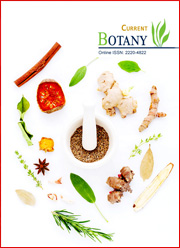Survival of transport-stressed black pepper stem cuttings after glucose, sucrose, fructose, and IBA treatments
DOI:
https://doi.org/10.25081/jp.2025.v17.9091Keywords:
Black pepper, Piper nigrum L., Stem cutting, Stem rooting, SugarsAbstract
This study aimed to determine the survival, sprouting, and rooting performance of black pepper stem cuttings to glucose, sucrose, and fructose at different concentrations. The two-node stem cuttings were prepared from six to seven-node cuttings collected from mother vines of black pepper in the field from far and remote areas in Sarawak, Malaysia. The two-node cuttings were soaked completely for one hour with the following treatments: 1% glucose, 2% glucose, 3% glucose, 1% sucrose, 2% sucrose, 3% sucrose, 1% fructose, 2% fructose, 3% fructose, and 1000 ppm IBA served as a positive control, while filtered water was a negative control. All treated cuttings were sown in the polybags containing soil mix and monitored daily for up to 45 days. The study found that black pepper cuttings treated with a 3% glucose solution exhibited significantly better survival, sprouting, and rooting, total number of roots, and total length of roots at day 45, but they were about the same when soaked in IBA at 1000 ppm. The present study demonstrates that cuttings that have been in transit for a long time require sugar and hormone treatment once they arrive at a certain location to restore their vitality and survival.
Downloads
References
Abo El-Enien, H. E., & Omar, M. A. (2018). Effect of some growth substances on rooting and endogenous hormones of Casimiroa edulis L. cuttings. Zagazig Journal of Agricultural Research, 45(3), 891-904. https://doi.org/10.21608/zjar.2018.49126
Agulló‐Antón, M. Á., Ferrández‐Ayela, A., Fernández‐García, N., Nicolás, C., Albacete, A., Pérez‐Alfocea, F., Sánchez‐Bravo, J., Pérez‐Pérez, J. M., & Acosta, M. (2014). Early steps of adventitious rooting: morphology, hormonal profiling and carbohydrate turnover in carnation stem cuttings. Physiologia Plantarum, 150(3), 446-462. https://doi.org/10.1111/ppl.12114
Agulló-Antón, M. Á., Sánchez-Bravo, J., Acosta, M., & Druege, U. (2011). Auxins or sugars: what makes the difference in the adventitious rooting of stored carnation cuttings? Journal of Plant Growth Regulation, 30, 100-113. https://doi.org/10.1007/s00344-010-9174-8
Ahmad, N., Fazal, H., Abbasi, B. H., Farooq, S., Ali, M., & Khan, M. A. (2012). Biological role of Piper nigrum L. (Black pepper): A review. Asian Pacific Journal of Tropical Biomedicine, 2(3), S1945-S1953. https://doi.org/10.1016/S2221-1691(12)60524-3
Aziz, Z. F. A., Halimi, M. S., Kundat, F. R., Jiwan, M., & Wong, S. K. (2015). Rhizobacterium Bacillus cereus induces root formation of pepper (Piper nigrum L.) stem cuttings. Research in Biotechnology, 6(2), 23-30.
Bahmani, R., Karami, O., & Gholami, M. (2009). Influence of carbon sources and their concentrations on rooting and hyperhydricity of apple rootstock MM. 106. World Applied Sciences Journal, 6(11), 1513-1517.
Bhattacharya, S., & Kundu, A. (2020). Sugars and sugar polyols in overcoming environmental stresses. In A. Roychoudhury & D. K. Tripathi (Eds.), Protective chemical agents in the amelioration of plant abiotic stress: Biochemical and molecular perspectives (pp. 71-101) New York, US: John Wiley & Sons Ltd. https://doi.org/10.1002/9781119552154.ch4
Business Today. (2022). Malaysian Pepper Board Seeks Market Expansion at Dubai Expo. Retrieved from https://www.businesstoday.com.my/2022/02/11/malaysian-pepper-board-seeks-market-expansion-at-dubai-expo/#:~:text=Malaysian%20pepper%20is%20ranked%20the,new%20markets%20across%20the%20region
Corrêa, L. D. R., Paim, D. C., Schwambach, J., & Fett-Neto, A. G. (2005). Carbohydrates as regulatory factors on the rooting of Eucalyptus saligna Smith and Eucalyptus globulus Labill. Plant Growth Regulation, 45, 63-73. https://doi.org/10.1007/s10725-004-6125-z
Custódio, L., Martins-Loução, M. A., & Romano, A. (2004). Influence of sugars on in vitro rooting and acclimatization of carob tree. Biologia Plantarum, 48, 469-472. https://doi.org/10.1023/B:BIOP.0000041107.23191.8c
Haq, I.-U., Imran, M., Nadeem, M., Tufail, T., Gondal, T. A., & Mubarak, M. S. (2021). Piperine: A review of its biological effects. Phytotherapy Research, 35(2), 680-700. https://doi.org/10.1002/ptr.6855
Jahnke, N. J., Dole, J. M., & Ashrafi, H. (2019). Simulated storage causes carbohydrate loss and rooting differences in two poinsettia cultivars. Canadian Journal of Plant Science, 100(4), 459-462. https://doi.org/10.1139/cjps-2019-0232
Jarvis, B. C. (1986). Endogenous control of adventitious rooting in non-woody cuttings. In M. B. Jackson (Eds.), New root formation in plant cuttings (pp. 191-222). https://doi.org/10.1007/978-94-009-4358-2_6
Malele, J., Kleynhans, R., Prinsloo, G., & Matsiliza-Mlathi, B. (2021). Optimizing the cutting production of Greyia radlkoferi. South African Journal of Botany, 142, 293-298. https://doi.org/10.1016/j.sajb.2021.06.037
Mehta, S. K., Singh, K. K., & Harsana, A. S. (2018). Effect of IBA concentration and time of planting on rooting in pomegranate (Punica granatum) cuttings. Journal of Medicinal Plants Studies, 6(1), 250-253.
Otiende, M. A., & Maimba, F. M. (2020). Endogenous carbohydrate content of the cutting positions at time of severance and IBA concentration influence rooting of Rosa hybrida rootstocks. Journal of Environmental and Agricultural Sciences, 22(1), 1-9.
Pawar, J. T., Khandekar, R. G., Mali, P. C., & Mane, A. V. (2020). Effect of different plant growth promoters on sprouting and survival in bush pepper (Piper nigrum L.). Journal of Pharmacognosy and Phytochemistry, 9(6), 1886-1888.
Pratibha, Panday, S. K., Chandravanshi, J., & Dhakad, B. (2021). Effect of different concentrations of IBA and Saccharides on growth parameters of semi-hard wood cuttings of pomegranate (Punica granatum L.) cv. Bhagwa. The Pharma Innovation Journal, 10(12), 2891-2896.
Sheikh, F. R., Jose-Santhi, J., Kalia, D., Singh, K., & Singh, R. K. (2022). Sugars as the regulators of dormancy and sprouting in geophytes. Industrial Crops and Products, 189, 115817. https://doi.org/10.1016/j.indcrop.2022.115817
Takahashi, F., Sato-Nara, K., Kobayashi, K., Suzuki, M., & Suzuki, H. (2003). Sugar-induced adventitious roots in Arabidopsis seedlings. Journal of Plant Research, 116, 83-91. https://doi.org/10.1007/s10265-002-0074-2
Vickers, L. A., Houser, J., Rooni, J., & Guldin, J. M. (2019). Some lessons learned on early survival and growth of containerized, locally-sourced ponderosa pine seedlings in the Davis Mountains of western Texas, US. Forests, 10(3), 267. https://doi.org/10.3390/f10030267
Yaseen, M., Ahmad, T., Sablok, G., Standardi, A., & Hafiz, I. A. (2013). Review: Role of carbon sources for in vitro plant growth and development. Molecular Biology Reports, 40, 2837-2849. https://doi.org/10.1007/s11033-012-2299-z
Published
How to Cite
Issue
Section
Copyright (c) 2025 Fitri Ab Aziz Zakry, Nur Natasya Ilyanis Idris, Muhammad Iqbal Nul Hakim Mohd Sazili, Franklin Ragai Kundat, Noorasmah Saupi, Semsolbahri Bokhari

This work is licensed under a Creative Commons Attribution 4.0 International License.





 .
.